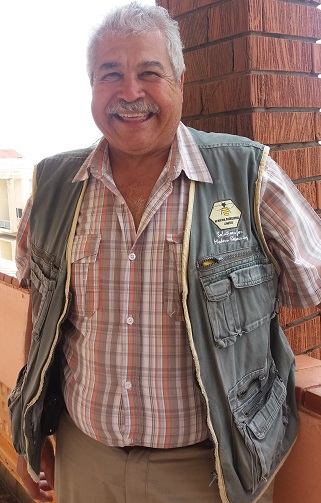
Value chains: all the buzz
Pauline Chemboi hated bees. They buzzed in your ear. They dined openly on your fruit. And the more you gave them a respectful distance, the more they refused to leave you alone. That was in 2013, back when she would sit up at night and worry about the next day’s meal. Today, she loves bees. And she’s never slept, or eaten, better.
“Owning beehives is traditionally a man’s job; we didn’t know we could it,” explains Pauline, beaming, as three of her Baringo County Self-Help Group colleagues tend to the hives behind her. “Many of us were afraid to start the venture, yet now here we are.”
Right around now is when most Hand in Hand Entrepreneur Stories would turn to our training or the generosity of our donors – and to be sure, both played a role. But this is a different kind of story, one that sheds light on the final, most opaque step in Hand in Hand’s job creation model: ‘linking members to larger markets’. Unique among third sector case studies, it starts not with indomitable women of X or the poverty-beating ambitions of Y, but with Ernesto Simeone, a gregarious Italian who saw an ad in the newspaper and decided he could make an easy buck.
Creating jobs in four (not so) simple steps
Hand in Hand’s four-step model is straightforward enough. First, we mobilise Self-Help Groups who support each other, save together and learn together. Second, we teach them the basics of business: bookkeeping, marketing and, if they lack bankable skills, the ins and outs of high-margin vocations such as honey production. Third, we provide microcredit to help them get up and running. And fourth – well, here’s where things can get a bit tricky.
At its core, ‘linking members to larger markets’ means helping them reach more customers. Sometimes that’s as simple as helping improve their branding and packaging. Other times, it means getting their products into actual, physical markets in nearby towns. Increasingly, however, we’re dreaming bigger and plugging our members into regional, national and even international value chains. It’s a strategy borne of a simple need: to make sure members’ businesses long outlast our support.
Which brings us to Ernesto.
The Italian job provider

Ernesto Simeone
Ernesto Simeone is a fitting poster-child for international value chains. Italian by heritage, he was born in Kenya, the son of an Italian POW who’d been “frogmarched from Ethiopia by the Brits”. His career in honey stretches back to 1994, when a Japanese company placed an advert in a Nairobi newspaper. “They were looking to buy honey from East Africa. I thought, that’ll be easy: buy some honey from the small-scale guys and sell it,” he says. “It didn’t work out that way.”
For one, the local ‘industry’, if you could call it that, needed modernising. “For me, the honey industry in east Africa is not beekeeping; it’s honey hunting. The quality being produced by these small-scale farmers is not very good. In fact, you can’t trade with it on the international market,” says Ernesto, whose company, an SME called African Beekeepers Limited (ABL), employs about 10 Kenyan staff. Local producers were sceptical of his outsider’s methods. And even if they hadn’t been, Ernesto lacked the infrastructure to train them at significant scale.
If only I could partner with an NGO that had proven experience training grassroots entrepreneurs, he thought.
Great minds
Two-hundred miles south in Nairobi, Hand in Hand Eastern Africa staff were poring through data on value chains. “If only Hand in Hand could partner with a honey producer capable of providing a market for our members,” someone said.
With so few players in Kenya’s honey industry, it wasn’t long before Hand in Hand rang ABL. Days later, they were in a room with Ernesto devising a sustainable, profit-based model that would benefit him, Hand in Hand and, most importantly, our members.
Here’s how it works.
Hand in Hand teaches Self-Help Groups the skills they need to run successful beekeeping enterprises, technical and otherwise. It also provides them with the means: microloans to pay for inputs such as beehives and suits. Ernesto’s company, ABL, sells them those inputs. It also provides them with an ongoing, reliable market – purchasing, packaging and selling their honey under its Bizzy Bee brand.
“Last week, our harvest was 188 kilos,” says Ernesto. “I paid Hand in Hand’s members 70,000 KES (US $700) direct through mobile banking. It’ll retail for about double that at supermarkets.”
As their profits grow, members repay Hand in Hand’s loans – which, in turn, get cycled back to new members. And for as long as people eat honey – whether in Japan or at home in Kenya – producers like Pascaline have work.
“This project has helped us a lot,” she says. “We can pay school fees and food for our homes. Every woman can now support her family.”
Results
1,400 entrepreneurs in honey value chains countrywide
Average yield per co-operative: 70,000 KES (US $700)
Women’s participation rate: 80%
Next case study: Meet Gloria, the former refugee growing crops – and profits
